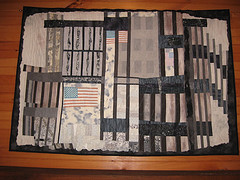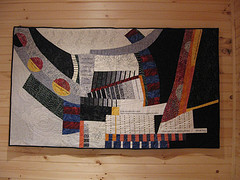
A quilt about 9/11, by Bonnie Resta-Flarer
I thought the quilts were paintings at first. I was on a tour of recently renovated cabins and bungalows in a small community in the Adirondacks a couple of weeks ago (I mentioned the tour in my post here).
The community had gone from mostly modest cabins to some pretty sophisticated places, thanks to renovations and new construction by the successful grandchildren of the original owners.
But the quilts were hanging in a place that had never been modest. The original building had been oversized and well-built, then divided into two separate residences, and now recently reunited as one amazing place with soaring spaces that dwarfed my city home.
The quilt that stole my heart was a commemorative of 9/11, relatively simply constructed for its straight seams, but a complex vision seen through dust-and-smoke-filled air. Quilt artist Bonnie Resta-Flarer, who owns and renovated the country house, is a city mouse from Brooklyn, and she had seen the towers fall from the windows of her Brooklyn studio.
Resta-Flarer’s background is as a painter. She studied at the Art Students League in New York, and she took every art course she could find at Brandeis. Once she ran out of art courses, she dropped out.
I asked her about some of her methods and materials that she used in the 9/11 quilt. She jet-printed some digital images onto fabric, using digital photos taken from a neighbor’s windows she said. She offered that when she printed, she backed the fabric with freezer paper, hot-ironing it on so it sticks to the fabric enough. After printing, she peels the paper away. “It’s pretty abusive on the printer,” she said. The fabric she printed on was a white on white jacquard, giving added texture to the printed images.
The other fabrics in the quilt, she said, are commonly produced quilting fabrics–just cotton. Since I had never been in a store that catered to quilters, she told me that many fabrics are designed with quilters in mind because of the kind of repeat patterns in them and the consistent color groups.
In the 9/11 quilt, Resta-Flarer used a number of grisaille batik prints, which have extremely small patterns, and she burnt edges and burnt holes. “I’ve always approached the quilting [i.e. the actual stitching] as a line drawing, a layer on top of the “painting” of piece work, which evolves from the original drawing as it’s stitched in place.
To me, what was so marvelous about this quilt, was the hazy air filled with smoke and debris. Everything in the piece was grayed out and muffled visually. I also loved the ways the various patterns built up the space without interrupting it, but offering closeup interest. The actual quilting and the unfinished, irregular burnt edges within the quilt seemed so much a part of the cityscape. The effect was subdued and mournful, the city’s grays punctuated by the declarations of patriotic defiance, the red, white and blue of the American flags. Their bright colors and the black of the jagged final remains of the World Trade Towers were grayed by the air. The piece immediately brought the post-9/11 mood back, reawakening all my memories.

The other quilt in the living room was based on the poem “Travel” by Carol Glasser Langille. The poem is excerpted on the quilt. The words are layered over and over, sometimes gray, sometimes black, sometimes readable, sometimes not quite readable. “I had the poem hanging in the studio for years.” The subject matter is more expected for a quilter–a woman’s life–but the poem is quirky, and the image swoops as the stitches circle like disturbed water.
“I love the whole process,” said Resta-Flarer, “picking the fabrics, seeing what goes, cutting the shapes. I put them on the wall, playing with them. That part of the process can go on for months. It’s like painting.
“Then there’s the sewing of the pieces together. Sometimes I take a picture so I have a reference. It’s like a puzzle–how the pieces are sewn together, in what order, so you have that seam line. The hardest thing is learning how to do the curves.”
But it was the quilt with the straight lines that was most interesting, most surprising for its subject matter, its painterly use of fabric, and the bold decisions like burning edges and holes. It went beyond the safe spaces of home and tidy seams to a world that was shaken up by terrorists.









